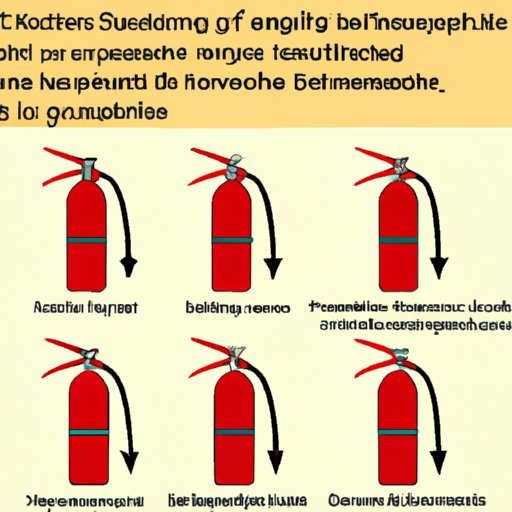The Proper Way to Use a Fire Extinguisher
As a homeowner, employee, or business owner, knowing how to use a fire extinguisher is an essential skill that can potentially save lives and protect properties. In this article, we will guide you on the step-by-step process of using a fire extinguisher, common mistakes to avoid, and the types of extinguishers and fires that they are effective in suppressing.
Step-by-Step Guide
Before we proceed to the actual process of using a fire extinguisher, it is essential to remember that fire extinguishers are designed to douse small, contained fires. In cases of large-scale fires or widespread flames, evacuation and calling the fire department are the best course s of action.
1. Identify The Fire
The initial step in using a fire extinguisher is to know what type of fire you are dealing with. There are four classes of fires: Class A is for combustibles such as wood and paper, Class B is for flammable liquids and gases like gasoline and propane, Class C is for electrical fires, and Class D is for flammable metals such as magnesium and aluminum. Class K fires are a subset of Class B fires that are created by cooking oils and fats and require specific extinguishers formulated for that purpose.
2. Ensure Safety
Always prioritize your safety first before attempting to put out a fire. If the fire is already uncontrollable, it is best to evacuate and call 911. Make sure you have access to an escape route before using a fire extinguisher.
3. Choose the Correct Extinguisher
There is no single-fire extinguisher that fits all types of fires. Different extinguishers are effective in various classifications of fires. Check the label of the extinguisher to know for which type of fires it is appropriate. For instance, ABC extinguishers, which are the most commonly used type of extinguisher, are suitable for fires involving combustibles, flammable liquids, and electrical fires.
4. Pull the Pin
The next step is to pull the pin on the extinguisher’s handle. This pin disengages th e locking mechanism and allows the extinguisher to discharge the compressed agent inside.
5. Aim at the Base of the Fire
Aim towards the base of the fire, as this is where the fuel source is situated. Keeping the nozzle in an upright position, hold the extinguisher at arm’s length. Avoid discharging the foam or powder directly onto the flames, as this can cause the fire to spread in other directions.
6. Squeeze the Handle
Depress the extinguisher’s handle or trigger to start the flow of the extinguishing agent.
7. Sweep from Side-to-Side
Move the nozzle back and forth until the flames are fully extinguished. Keep on moving forward slowly as the extinguishing agent starts to release, making sure that the flames don’t re-ignite.
Visual Guide
Visual aids help better understand the process. Here, we provide an infographic or video demonstrating the steps of using a fire extinguisher.
Common Mistakes
Some common mistakes that people make when using fire extinguishers include:
- Using the wrong type of extinguisher for the fire being faced
- Getting too close to the fire
- Not aiming at the base of the fire
- Using an expired extinguisher
To avoid making these mistakes, ensure that the extinguisher in use is up-to-date and appropriate for the type of fire you are dealing with, stand a minimum of six feet away from the fire, aim at its base, and always have a clear emer gency exit.
Types of Fire Extinguishers
The most common types of fire extinguishers are:
- Class A extinguishers – Suitable for fires started by combustible materials
- Class B extinguishers – Suitable for fires caused by flammable liquids and gases
- Class C extinguishers – Suitable for electrical fires
- Class D extinguishers – Suitable for fires involving flammable metals
- Class K extinguishers – Specifically formulated for fires caused by cooking oils and fats
Using the wrong type of extinguisher on a fire can be counterproductive and lead to accidents. It is essential to ensure you are using the correct type, as stated on the extinguisher label, for the specific fire hazard.
Fire Safety
Being knowledgeable in extinguishing small-scale fires is just one aspect of an inclusive fire safety plan. It is also important to be aware of how to prevent fires from happening in the first place. Other fire safety strategies include:
- Proper storage of flammable materials
- Having working smoke detectors
- Regular cleaning of chimneys and heating equipment
- Crafting and practicing an evacuation plan
Practice and Preparation
It is not enough to own a fire extinguisher; one must also be competent in its operation. Practicing using a fire extinguisher will help you handle emergencies effectively. Schedule regular fire drills to ensure your family members or employees understand emergency procedures. Make sure your equipment is well-maintained and placed in easily accessible locations.
Quiz or Game
Testing your knowledge through interactive activities can be engaging and enjoyable. Here, we provide some questions to test your understanding of how to use a fire extinguisher:
- What is the first step in using a fire extinguisher?
- What type of fires is a Class A fire extinguisher effective in extinguishing?
- Can you use a Class ABC extinguisher to put out a Class D fire?
- What is the correct procedure for using a fire extinguisher?
- What are some common mistakes to avoid when using a fire extinguisher?
Conclusion
Knowing how to properly use a fire extinguisher is vital in preventing fires and protecting yourself and others from harm. Always prioritize safety and be confident in using the correct type of fire extinguisher for the specific fire hazard. Remember to practice and maintain the extinguisher regularly to ensure its effectiveness in emergencies.
